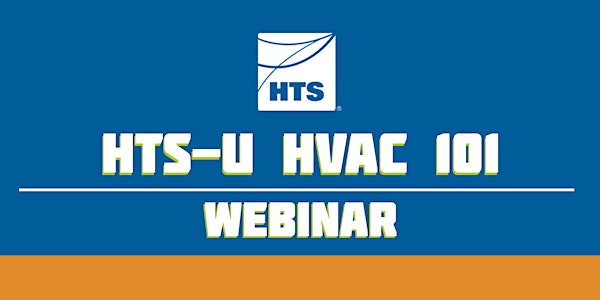
HTS-U Ontario June 2020
The HVAC/R Fundamentals 101 course is a 10-week training program designed to enhance fundamental HVAC engineering skills.
Date and time
Location
Online
Refund Policy
About this event
IN RESPONSE TO THE COVID-19 VIRUS IN ONTARIO, WE ARE CHANGING OUR FORMAT OF HTS-U TO AN ONLINE WEBINAR.
You have the choice of registering for the Wednesday Afternoon Series OR the Thursday Morning Series.
Wednesday Afternoon (4PM - 6PM) : Starting June 24th - September 2nd
Thursday Morning (8AM - 10AM) : Starting June 25th - September 3rd
Details of Each Module
Module 1 - Building Loads and Indoor Air Quality
Heating and cooling loads are the primary basis for sizing heating and cooling equipment. They determine the size of the equipment, ductwork, and piping. These items in turn have a significant impact on the initial cost of new construction. Students will learn the standards and methods needed to assess sizing.
Module 2 - Psychrometrics
This module will discuss the fundamental of psychrometrics, including a detailed review of the psychrometric chart, with a focus on temperature, humidity, dew point and other important parameters used every day in the HVAC industry. Students will be shown examples of how psychrometrics can be applied in both simple, and complex situations involving multiple air treatment devices. Students will be challenged by solving problems, followed up with step by step solutions to the examples.
Module 3 - Duct Design
The focus of the duct design training is to teach air pressure and airflow basics, typical duct layouts, and different design principles. Hands-on learning will allow students to design a typical duct system and calculate the pressure losses.
Module 4 - Fans and Motors
This training module is designed to provide an overview of the physical & performance characteristics of fans as well as an understanding of the importance of fan efficiencies. Students will be able to identify the various types of fans. Understanding of site issues and how to overcome them using fan laws and static pressure profiles will also be demonstrated. Students will be able to evaluate a fan curve and sound data in order to provide ideal fan selections. Finally, students will come away with an understanding of the impact of fan/motor efficiencies on operating costs.
Module 5 - Acoustics
This module will focus on acoustic fundamentals covering the following definitions of sound pressure and sound power; DBA, DBC (A-weighted and C-weighted); taking sound power from AHU to NC; octave band analysis; analysis of NC chart and human behavior towards specific bands, analysis of noise, sound absorption; mechanical room construction and ceiling construction; fan selections and sound tests; and AHU design.
Module 6 - Refrigeration Cycle and Piping Design
The focus of this training module is the vapor compression refrigeration cycle as it is used for comfort cooling. With this module, the student will be able to differentiate between various refrigerants and the components within the direct expansion (DX) piping layout. The student will also be able to size DX lines between evaporators and condensers given a set of specific jobsite conditions. We will briefly cover application considerations such as hot gas bypass, heat pump mode and low ambient cooling operation.
Module 7 - Hydronic System Design
This module will begin with a brief overview of the refrigerant cycle followed by a review of various HVAC building systems including DX, Chilled Water, and Condenser Water Systems. We will focus on hydronic piping design including open vs closed systems, pipe friction calculations and proper system design practices. In order to get a full understanding of piping systems we will explore various components such as pumps, expansion tanks and solid separators. The second part of the module will introduce students to chilled water piping systems such as constant flow pumping, primary-secondary and variable primary pumping.
Module 8 - Automated Temperature Controls
This purpose of this module is to educate the participants on the different levels of a BAS system (Management, Integration, Field Controller, Field Devices) and how they will fit together. It will discuss the operator interface, networking and integration, programming and programming building blocks as well as the controlled devices (valves, dampers, sensors). The session will also review common HVAC systems and typical controls for them.
Module 9 - Engineering and System Economics
A review of the requirements in the building code for seismic restraints for non structural components and how to achieve compliance. This module will define some of the terminology used in ASHRAE 90.1 and how to calculate simple payback and cash flow analysis. The second half of the class will cover the energy used in different systems and the cost of that energy to help evaluate which system should be used. Total cost of ownership with be emphasized.
Module 10 - System Selection
This module will focus on how to determine the correct system for your building. We will review different building types such as office towers, condos, and schools to understand the limitations and requirements of each. We will also review different equipment (roof top units, chilled water plants, how water plants, self-contained, VRV, WSHP) and where each one fits best.